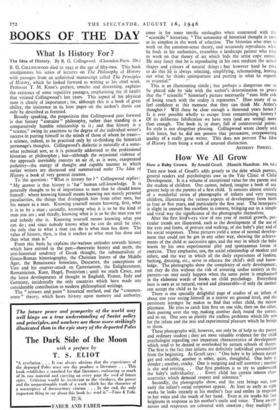How We All Grow
How a Baby Grows. By Arnold Gesell. (Hamish Hamilton. 10s. 6d.)
THIS new book of Gesell's adds greatly to the debt which parents, general readers and psychologists owe to the Yale Clinic of Child Development. It is a volume of exceptional value for the parent and the student of children. One cannot, indeed, imagine a book of any greater help to the parents of a first child. It consists almost entirely of a wonderful series of photographs of infants and very young children, illustrating the various aspects of development from birth to four or five years, and particularly the first year. The letterpress' is slight in amount but excellent in content, bringing out in a simple and vivid way the significance of the photographs themselves.
After the first bird's-eye view of one year of mental growth, par- ticular trends are illustrated, such as the development of the use of the eyes and limbs, of posture and walking, of the baby's play and of his social responses. These pictures yield a sense of normal develop- ment that could not be got in any other way, showing the achieve- ments of the child at successive ages, and the way in which the baby learns by his own experimental play and spontaneous forms ot exercise. They emphasise, too, the social relationship of mother and infant, and the way in which all the daily experiences of feeding, bathing, dressing, etc., serve to educate the child's skill and know- ledge. The photographs show the complexity of early development., yet they do this without the risk of arousing undue anxiety in the parents—as may easily happen when the same point is emphasised in the elaborate words of books on child psychology. Everything here is seen as so natural, varied and pleasurable—if only the mother can accept the child as he is.
There is one specially delightful page of studies of an infant of about one year seeing himself in a mirror on ground level, and the persistent attempts 'he makes to find that -other child, the mirror playmate. He tries to catch him first on one side, then on the other, then peering over the top, making another dash round the corner, and so on. One sees so plainly the endless problems which life sets for the infant and the zest and experimental pleasure which he brings to them.
These photographs will, however, not only be of help to the parent and ordinary student ; they are most valuable evidence for the child psychologist regarding two important characteristics of development which tend to be denied or overlooked by certain schools of theory. The first is the fact that infants are definitely individual personalities from the beginning. As Gesell says : "One baby is by inborn nature gay and sociable, another is sober, quiet, thoughtful. One baby is slender ; another, stocky. One is outgoing and self assertive • another is shy and retiring. . . Our first problem is to try to understand the baby's individuality. . . Every child has certain inborn char; acteristics which demand respect and tolerance."
Secondly, the photographs show, and the text brings out, how early the infant's social responses appear. At least as early as eight weeks he looks intently at his, mother's face and smiles in response to her voice and the tomb of her hand. Even at six weeks his face brightens in response to his mother's smile and voice. These aware- nesses and responses are coloured with emotion ; they multiply in variety and complexity with every day of development, and are deeply affected by his actual experiences.
There are those among psychologists who in order to suit certain rigid theories, deny the reality of this early social relationship of mother and infant, and look upon the infant as a simple bundle of reflexes, subject to mere " conditioning " by the environment. It is hard to see how they can maintain such denial in the face of these photographs which substantially justify the view held by many close observers that mother and child form from the first a psychological unit ("The Nursing Couple," as Merell Middlemore put it), and that the baby's social awareness soon extends to a wider circle.
From his most immature days, in fact, the infant is a human being who responds in characteristic ways to other human beings.
Sus AN ISAACS.



























 Previous page
Previous page